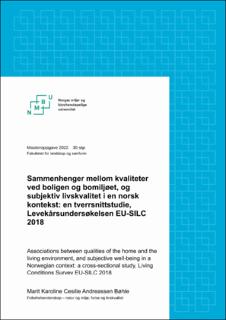| dc.contributor.advisor | Raanaas, Ruth Kjærsti | |
| dc.contributor.advisor | Nes, Ragnhild Bang | |
| dc.contributor.author | Bøhle, Marit Karoline Cesilie Andreassen | |
| dc.coverage.spatial | Norway | en_US |
| dc.date.accessioned | 2022-11-02T09:43:48Z | |
| dc.date.available | 2022-11-02T09:43:48Z | |
| dc.date.issued | 2022 | |
| dc.identifier.uri | https://hdl.handle.net/11250/3029529 | |
| dc.description.abstract | Bakgrunn: Bolig og bomiljø er grunnleggende behov og viktige helsedeterminanter, samt viktige faktorer for livskvalitet. Kunnskap om befolkningens livskvalitet er et viktig mål i seg selv og også for samfunnsutviklingen. For å møte klimautfordringene og befolkningsøkningen foregår det i dag en fortetting- og knutepunktspolitikk. Det bygges høyere og tettere og på et mindre areal som går på bekostning av grønne områder. Det trengs kunnskap om hvordan kvaliteter ved boligen som dagslys og størrelse, og bomiljøet som tilgang til privat hage og grønne områder, påvirker livskvaliteten.
Formål: Studiens formål var å undersøke hvilke sammenhenger som finnes mellom kvaliteter ved boligen og bomiljøet, og subjektiv livskvalitet i en norsk kontekst.
Metode: Denne studien er en tverrsnittstudie med datasett fra Levekårsundersøkelsen EU-SILC 2018. Det er utført deskriptive analyser, samt ujusterte og justerte lineære regresjoner med livskvalitetsmålene, affektiv livskvalitet og livstilfredshet som avhengige variabler. Uavhengige variabler for boligkvalitet har vært hustype, antall rom, boligstørrelse m2, subjektiv opplevelse av boligstørrelsen, dagslys, støy og terrasse/balkong. Uavhengige variabler for bomiljøet har vært egen tomt/hage, lek og rekreasjonsmuligheter, naturterreng, trafikkforhold, støv, lukt og forurensing, samt støy.
Resultat: Alle variablene viste signifikant sammenheng med livskvalitetsmålene i de ujusterte analysene. Hovedfunn fra de justerte analysene når det ble kontrollert for andre boligkvalitetsvariabler, bomiljøvariabler samt mulige konfundere, viste at boligkvalitetsvariablene subjektiv opplevelse av boligstørrelsen, ikke problemer med dagslys og støy innendørs er assosiert med høyere livskvalitet for begge livkvalitetsmålene. For bomiljøkvaliteter var det trafikkforhold, støy fra bedrifter, bygg- og anleggsvirksomhet, samt støv, lukt og forurensing som hadde sammenheng med høyere affektiv livskvalitet.
Konklusjon: Studien avdekket at det er sammenhenger mellom boligkvaliteter og bomiljøkvaliteter og livskvalitet. Hovedfunnene tyder på at bomiljøkvaliteter ikke kan kompensere for dårlige boligkvaliteter sett i sammenheng med livskvalitet. Studien viser at det er behov for mer kunnskap og at dette er noe som trengs å utforskes mer, spesielt i forhold til forebyggende- og helsefremmende folkehelsearbeid. | en_US |
| dc.description.abstract | Background: Housing and living environment are basic needs and important health determinants, as well as important factors for well-being. Knowledge of the population's well-being is an important goal in itself and also for societal development. To meet climate challenges and population growth, a densification and key-node policy is currently employed. This means that buildings are constructed higher and closer together in smaller areas, sometimes at the expense of green zones. Knowledge is needed about how quality of housing and living environment, such as daylight and size as well as access to private gardens and green zones, affect well-being.
Purpose: The purpose of the study was to investigate connections between quality of housing and living environment, and subjective well-being in a Norwegian context.
Method: This study is a cross-sectional study with data sets from the EU-SILC Life Year Survey 2018. Descriptive analyzes were performed, as well as unadjusted and adjusted linear regressions with well-being goals, affective well-being and life satisfaction as dependent variables. The independent variables for housing quality were type of house, number of rooms, size in m2, subjective experience of size, daylight, noise, and terrace/balcony. The independent variables for living environment were separate plot/garden, nature, play and recreational opportunities, traffic conditions, dust, odor and pollution, and noise.
Results: All variables associated with the well-being goals in the unadjusted analyzes. Main findings from the adjusted analyzes when checked for other housing quality variables, living environment variables and possible confounders, showed that the housing quality variables subjective experience of size, not problems with daylight and indoor noise, were associated with higher well-being for both well-being goals. In respect to living environment qualities, the variables traffic conditions, noise from companies, building and construction activities, odors and pollution, and dust were associated with higher affective well-being.
Conclusion: The study revealed that there are associations between qualities of housing and living environment, and well-being. The main findings indicate that living environment qualities cannot compensate for poor housing qualities linked to well-being. The study shows that there is a need for more knowledge and that the matter should be explored further, especially in health-promoting and preventive public health work. | en_US |
| dc.language.iso | nob | en_US |
| dc.publisher | Norwegian University of Life Sciences, Ås | en_US |
| dc.rights | Attribution-NonCommercial-NoDerivatives 4.0 Internasjonal | * |
| dc.rights.uri | http://creativecommons.org/licenses/by-nc-nd/4.0/deed.no | * |
| dc.title | Sammenhenger mellom kvaliteter ved boligen og bomiljøet, og subjektiv livskvalitet i en norsk kontekst : en tverrsnittstudie, Levekårsundersøkelsen EU-SILC 2018 | en_US |
| dc.title.alternative | Associations between qualities of the home and the living environment, and subjective well-being in a Norwegian context : a cross-sectional study, Living Conditions Survey EU-SILC 2018 | en_US |
| dc.type | Master thesis | en_US |
| dc.description.localcode | M-FOL | en_US |

